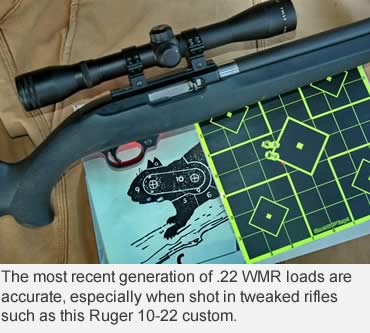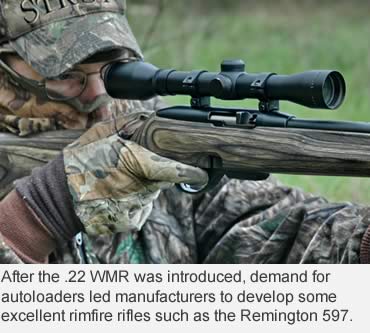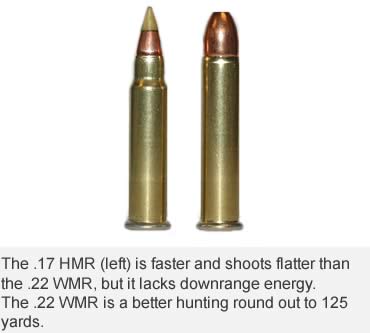By J. Wayne Fears
Often misunderstood, the .22 Mag is a serious stopper of small game up to 20 pounds.
I never told my hunting companions the caliber of the Henry lever-action rifle I was carrying. They just assumed it was a .22 Long Rifle.
We were on a mission for a church wild game supper. Thanks to its many members who were hunters, the church had a wide variety of wild game to serve, but an old favorite was in short supply. Many wanted to try raccoon, and I had been recruited to come up with one quickly.
A friend had two Walker hounds that I knew would help make finding a raccoon quick and easy. Several members of the church group putting on the supper wanted to tag along on the hunt.
The dog’s owner and I had an audience as we followed the dogs in a large river bottom swamp. Soon, as I had predicted, the two Walkers were hot on the trail, their sweet music filling the air. In short order, they began the baying that told us the raccoon had taken refuge in a tree.
The dogs were circled around a large water oak. The big raccoon was just a ball of fur in the top of the tree.
“You can’t take him with that little .22,” one in the group stated. Another added, “That coon will still be alive when he hits the ground.”
I asked the houndsman to pull the dogs away so they wouldn’t chew up the potential supper, and got a good rest on a nearby hickory. “You’re going to mess up the meat if you shoot him enough times to knock him out of the tree,” another sighed.
I could see the head of the coon and took aim in the center. At the crack of the .22 WMR, the raccoon tumbled to the ground. He didn’t twitch, and none of the meat was ruined.
“What are you shooting?” one in the group asked. “That’s not a .22,” another opined.
We had a fat raccoon for the church supper, and the overlooked .22 WMR picked up several more new fans.
 The History
The History
The .22 Winchester Magnum Rimfire (WMR), often called .22 Mag, was introduced by Winchester in 1959. Soon after the new cartridge rolled out, Ruger, Savage and Smith & Wesson built guns for the new caliber. These included revolvers or bolt-action, pump, single-shot and lever-action rifles.
The .22 WMR was the answer for shooters who had wished for a rimfire cartridge accurate to 125 yards and having enough energy to take game and varmints up to 20 pounds.
The .22 Mag has a larger case than the .22 Long Rifle both in diameter and length. Its case is thicker, too, allowing higher chamber pressures.
The bullet diameter is .224 inches, the same as centerfire .22s’. This was appreciated as new bullets came along in .224 diameter.
The first cartridges were loaded with 40-grain hollowpoints with thin jackets and full metal bullets. Shot from a rifle, they attained 2,000 fps muzzle velocity and 1,550 fps from a pistol barrel.
Later, they were revised to 1,910 fps and 1,480, respectfully. The muzzle energy was listed at 360 foot-pounds — almost twice the speed and energy of a 40-grain .22 Long Rifle high-velocity cartridge.
The magnum in a small package was off to a good start.
Early Tests Afield
My introduction to the cartridge came in 1965, when I was working as a wildlife agent in Georgia. Part of my job description was to take all predator complaints from the local farmers. One morning, a woman called and said that hawks were killing all her yard chickens. If I didn’t come immediately and give her some help, she promised, she’d take her shotgun and start killing every hawk she saw.
I’d just received a new Savage Model 24 with a .22 WMR barrel sitting over a .410 shotgun barrel. I had mounted a 4x Weaver scope on the gun, and it was a tack driver at 100 yards. Since most problem predators back in those days were foxes, bobcats, raccoons, opossums and an occasional weasel, not hawks, I thought the Savage Model 24 would be the ideal gun for predator control.
I arrived at the lady’s small farm the next day, and after looking around in her dusty yard, I found the tracks of the chicken thief, a gray fox. I put on my camo outfit and went into the woods just behind her smokehouse. Using an Olt predator call, I began a loud series of dying rabbit screams.
It didn’t take long to get results. Within minutes of beginning the calls, I saw a fox slipping along the edge of the woods 60 yards to my right.
He had been spoiled with his easy meals. I eased up the Savage, found the fox’s head in the scope and sent a 40-grain solid bullet just behind his eye. It was over in an instant. The .22 WMR did an outstanding job.
The next occasion I had to use the .22 WMR in my work was in the middle 1970s. I was working with an experimental quality deer management program in Alabama. We needed to take several does for research purposes, and after some planning, decided to head-shoot the animals using a Winchester Model 9422 in .22 WMR. In the hands of a skillful shooter, it became the favorite gun for taking does for this project. The cartridge put them down instantly.
I liked the caliber so well, I purchased a Ruger Single Six in .22 WMR after the project was finished. The revolver is still one of my favorite belt guns for taking small game and for plinking.
Improved Guns
During the early years of the .22 WMR, I wasn’t the only one who saw the potential of the powerful little rimfire. Gun and ammo companies began to hear from small game and varmint hunters wanting more loads and a variety of firearms, including autoloading rifles and pistols.
Coming up with an autoloader presented somewhat of a challenge, as the .22 WMR operates at higher pressures than inertia-driven actions typically can handle. However, in the 1990s, Marlin, Savage and Ruger developed the autoloaders that shooters were eagerly awaiting. Soon after, Remington followed with the Model 597.
The .22 WMR adapts well to revolvers. Major companies such as Taurus, Smith & Wesson, Charter Arms, Freedom Arms, Ruger and North American Arms offer revolvers in this powerful rimfire.
Currently, there are two autoloading pistols available that I am familiar with: the High Standard Automag II and the Excel Accelerator.
 Improved Loads
Improved Loads
As mentioned earlier, the first loads for the .22 WMR were jacketed hollowpoint and full-metal jacket rounds. Hunters liked the caliber, but they wanted faster, harder-hitting and more accurate ammunition.
Loads fitting that description today include Federal’s 30-grain V-Shok that exits the barrel at 2,200 fps and packs 134 foot-pounds of energy at 100 yards. The bullet is a Speer TNT hollowpoint, which provides tight groups and quick expansion.
Hornady’s 30-grain V-Max features a polymer tip, making it safe to load in rifles with tubular magazines.
Remington has a similar polymer-tip load, the Premier .22 Win Mag with a 33-grain AccuTip-V bullet.
I have found all of these loads to be very accurate out to 125 yards. Zeroed at 100 yards, they drop about 2.5 inches at 125 yards and 5 inches at 150.
For those who want heavier loads, Winchester offers the Dynapoint 45-grain, and Federal offers the 50-grain Game-Shok JHP.
For varmint control such as mice and snakes, CCI has a shot load that features 31 grains of No. 12 shot in a plastic capsule. It has a muzzle velocity of 1,000 fps and is good for 15 feet. I have used it when wading in cottonmouth territory. This load will not cycle in autoloaders, but it can be cycled manually.
It has been my experience that each rifle has its own personality, and you have to try different loads to find which one shoots best in that gun. But when you match the right load to the right rifle or handgun, you will have a midrange small game/varmint gun that has a low recoil and low report.
Also, depending upon where you purchase your ammo, it can cost less to shoot the .22 WMR than its competitors such as the .17 HMR, .22 Hornet or the .17 Remington Fireball.
During the past year, I have used the .22 WMR for hunting squirrels, groundhogs, prairie dogs and beavers without any misgivings. In fact, when doing beaver control near populated areas, I really favor the .22 WMR. I have never seen a head shot fail to stop the pest in its tracks.
When the hunt is over, the .22 WMR is a fun gun to use for target practice or plinking.
My children and grandchildren started their shooting adventures with a .22 LR, and the .22 WMR was the next step toward the centerfire. They still enjoy shooting the little magnum.
Often overlooked and misunderstood, the .22 WMR is a serious 125-yard stopper for 2- to 20-pound critters and even larger game and varmints when a head shot is possible.
 .22 WMR Vs. .17 HMR
.22 WMR Vs. .17 HMR
When the .17 HMR came out in 2002, it was instantly popular. Many hunters predicted it would be the death of the .22 WMR. In many ways, it does surpass the .22 WMR, but in one important area, especially to hunters, the .22 WMR remains king.
Let’s compare the .17 HMR in a 20-grain XTP to a .22 WMR in a 40-grain JHP. In velocity, the .17 HMR exits the muzzle at 2,375 fps and is traveling at 1,754 fps at 100 yards The .22 WMR is slower: 1,910 fps at the muzzle and 1,325 fps at 100 yards.
Give the velocity championship to the .17 HMR.
In trajectory, the .17 HMR 20-grain load is plus 0.6 inches at 50 yards and minus 4.1 inches at 150 yards. The .22 WMR is plus 0.9 inches at 50 yards and minus 5.7 at 150 yards.
The .17 HMR is a little flatter-shooting than the .22 WMR and has a longer range of accuracy than the .22 WMR. Do the math, and you’ll find the .17 HMR is a 150-yard rifle, and the .22 WMR is a 125-yard rifle.
But hunting and pest control is about energy, the killing power of a load. Here, the .17 HMR falls short. It has 250 foot-pounds of energy at the muzzle and 140 foot-pounds at 100 yards. The .22 WMR has 324 foot-pounds of energy at the muzzle and 156 foot-pounds at 100 yards — 16 more foot-pounds of killing power than the .17 HMR.
Both calibers have a place in small game/varmint hunting. The .22 WMR is my choice out to 125 yards. Beyond that, the .17 HMR gets the nod.
Thanks to improved .22 WMR ammunition and firearms, a lot of hunters who left the .22 WMR for the .17 HMR are returning.
This article was published in the August 2009 edition of Buckmasters GunHunter Magazine. Subscribe today to have GunHunter delivered to your home.